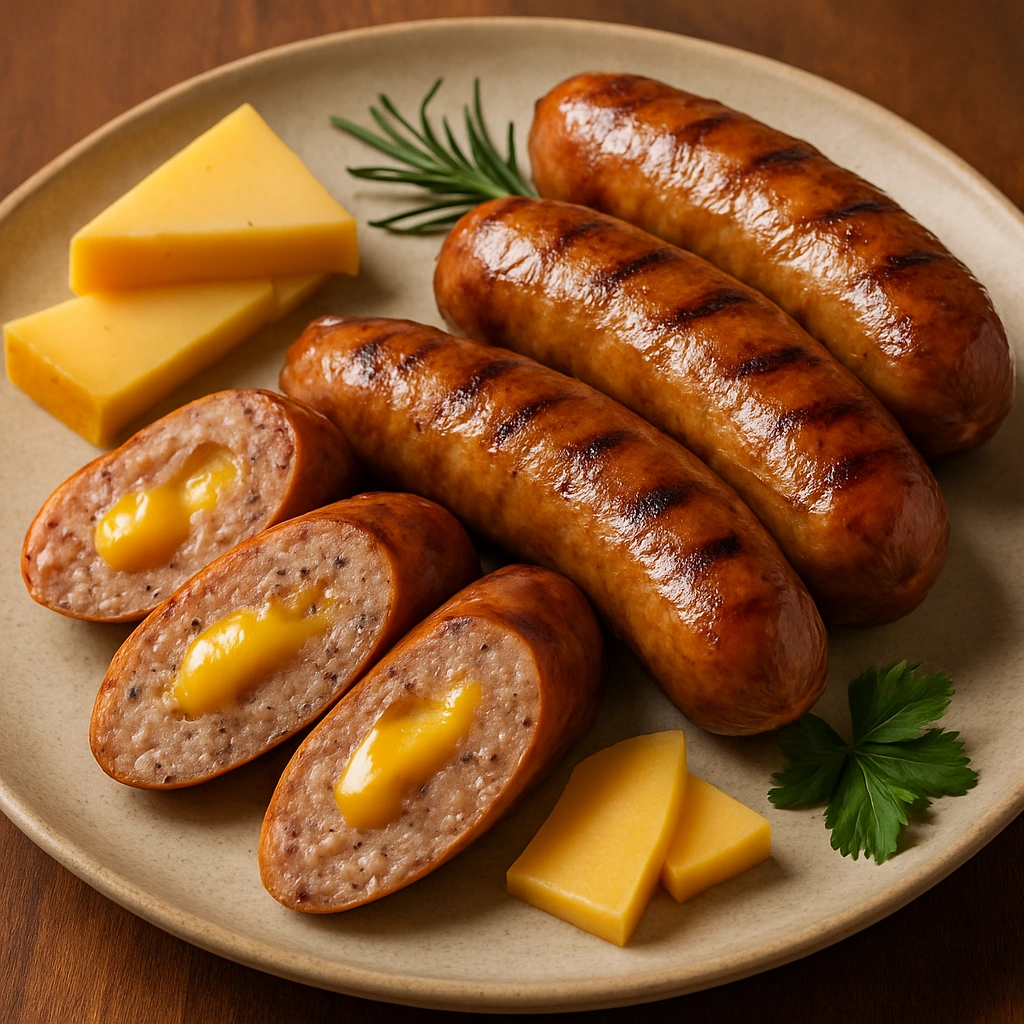
Cheese sausage represents the perfect marriage of two beloved foods: savory sausage and rich, melty cheese. While this combination seems straightforward, the world’s best chefs have elevated this humble creation to culinary excellence through technique, quality ingredients, and creative vision. In this guide, we’ll explore how top chefs approach cheese sausage and how you can bring these professional techniques into your own kitchen.
Table of Contents
Introduction
Cheese sausage has roots in multiple culinary traditions, from Polish kielbasa with cheese to German käsekrainer. What makes these sausages special is the perfect balance between the savory meat and the creamy cheese, creating a harmony of flavors and textures greater than the sum of its parts.
Chef Thomas Keller says, “The beauty of cheese sausage lies in its contrasts—the firm exterior giving way to pockets of molten cheese creates a sensory experience that engages both the palate and the mind.” This philosophy of contrasting textures is a hallmark of how top chefs approach this versatile ingredient.
From casual backyard cookouts to Michelin-starred restaurants, cheese sausage continues to evolve as chefs experiment with different cheese varieties, meat blends, and cooking techniques. Let’s explore how the world’s culinary masters create and use these delectable links.
Ingredients
Chef-Recommended Base Ingredients:
- 2 pounds high-quality pork shoulder (80% lean, 20% fat), as recommended by Chef Sean Brock
- 8 ounces cheese of choice (Chef Dominique Crenn suggests using a mix of 75% high-moisture cheese like Gruyère and 25% low-moisture cheese like aged cheddar)
- Natural hog casings (Chef David Chang insists on natural over synthetic for better texture and flavor development)
Chef Michael Symon’s Signature Spice Blend:
- 2 tablespoons kosher salt
- 1 tablespoon freshly ground black pepper
- 2 teaspoons garlic powder
- 1 teaspoon smoked paprika
- 1 teaspoon dried oregano
- 1/2 teaspoon ground coriander
- 1/4 teaspoon cayenne pepper
Chef Nancy Silverton’s Flavor Enhancers:
- 1/4 cup chilled white wine (preferably Riesling)
- 2 tablespoons toasted fennel seeds
- 1 tablespoon lemon zest
- 2 cloves black garlic, finely minced
Chef Gordon Ramsay’s Recommended Accompaniments:
- Caramelized onions deglazed with aged balsamic vinegar
- Artisanal mustard with whole grain and honey
- Freshly baked pretzel rolls
- Quick-pickled cucumber and radish slices
Execution
Chef Massimo Bottura’s Cold-Preparation Method:
- Chill all equipment (grinder, bowl, blades) for at least 1 hour before beginning
- Cut meat and fat into 1-inch cubes and place in freezer for 30 minutes
- Cube cheese and freeze solid for at least 2 hours
- Grind meat through a medium die at high speed to minimize heat
- In a chilled mixing bowl, combine ground meat with spices and liquid ingredients
- Mix aggressively with gloved hands for 2 minutes until slightly sticky
- Gently fold in frozen cheese cubes
- Rest mixture in refrigerator for 1 hour before stuffing
Chef April Bloomfield’s Stuffing Technique:
- Soak natural casings in lukewarm water for 30 minutes, changing water twice
- Thread casing onto sausage stuffer nozzle, leaving 6 inches hanging free
- Fill stuffer with meat mixture, eliminating air pockets
- Stuff casings with steady, even pressure, avoiding overfilling
- Twist into 6-inch links, alternating direction for each link
- Use a sterilized needle to prick any air bubbles
- Hang links at room temperature for 30 minutes to dry slightly before cooking
Chef José Andrés’ Two-Stage Cooking Method:
- Bring water to 170°F (77°C) in a large pot
- Poach sausages for 15 minutes to partially cook and set the structure
- Remove and pat dry thoroughly
- Refrigerate for up to 3 days or proceed directly to final cooking
- Finish on a grill over medium-high heat for 8-10 minutes, turning frequently
- Rest sausages for 3-5 minutes before serving
Chef Heston Blumenthal’s Molecular Gastronomy Approach:
- Prepare sausages as above but add 0.2% sodium citrate to the cheese before freezing
- This prevents the fat in the cheese from separating during cooking
- After forming links, place in a vacuum-sealed bag
- Cook sous vide at 152°F (67°C) for 45 minutes
- Finish with a kitchen torch or in a cast-iron skillet with clarified butter
Additional Tips
Chef Daniel Humm’s Quality Control Insights:
- “Temperature control is everything—never let your meat mixture exceed 40°F during preparation”
- Use cheese with at least 45% fat content for optimal melting properties
- For testing flavor without cooking a whole sausage, pan-fry a small patty
- Allow cooked sausages to rest 3-5 minutes before cutting to prevent cheese from escaping
Chef Dominique Ansel’s Creative Variations:
- Substitute up to 25% of the pork with another meat for unique flavor profiles
- Try duck with Roquefort cheese for a French twist
- Lamb with feta and mint creates a Mediterranean profile
- Veal with fontina and sage offers Italian elegance
- Experiment with cheese infusions by combining soft cheese with herbs or spices before freezing
Chef Niki Nakayama’s Technique Refinements:
- Soak casings in water infused with white wine and bay leaves for enhanced flavor
- For consistent cheese distribution, use a coarse grind for meat but dice cheese by hand
- Keep cheese cubes uniform at 1/4 inch for even melting
- When mixing, maintain a rhythmic folding motion rather than aggressive kneading
- For leaner meats, add 1 tablespoon olive oil per pound to maintain moisture
Chef René Redzepi’s Serving Innovations:
- Serve alongside pickled items with contrasting acidity
- Create a mustard tasting flight with varied heat levels and sweetness
- Consider temperature contrast by serving hot sausage with chilled accompaniments
- For presentation, slice on a bias and fan out to display the cheese pockets
- Garnish with unexpected elements like fermented vegetable powders or herb oils
Conclusion
As Chef David Chang notes, “The humble cheese sausage teaches us that perfection often lies in simplicity executed with impeccable technique.” By incorporating these chef-driven methods into your sausage making, you’ll elevate this classic to new heights.
The key takeaways from the world’s best chefs all point to the same fundamentals: maintain cold temperatures throughout preparation, use the highest quality ingredients you can access, and pay attention to the details of texture and balance. Whether you’re serving these sausages at a family barbecue or as part of an elegant charcuterie display, these professional techniques will ensure exceptional results.
For more insights on charcuterie and sausage making, check out our complete guide to homemade charcuterie or explore our interviews with Michelin-starred chefs about their approaches to classic dishes.
What chef-inspired technique are you most excited to try with your cheese sausage? Let us know in the comments below!
Related Article: Easy Cottage Cheese Egg Bake
This blog post features techniques compiled from various renowned chefs and culinary experts.
